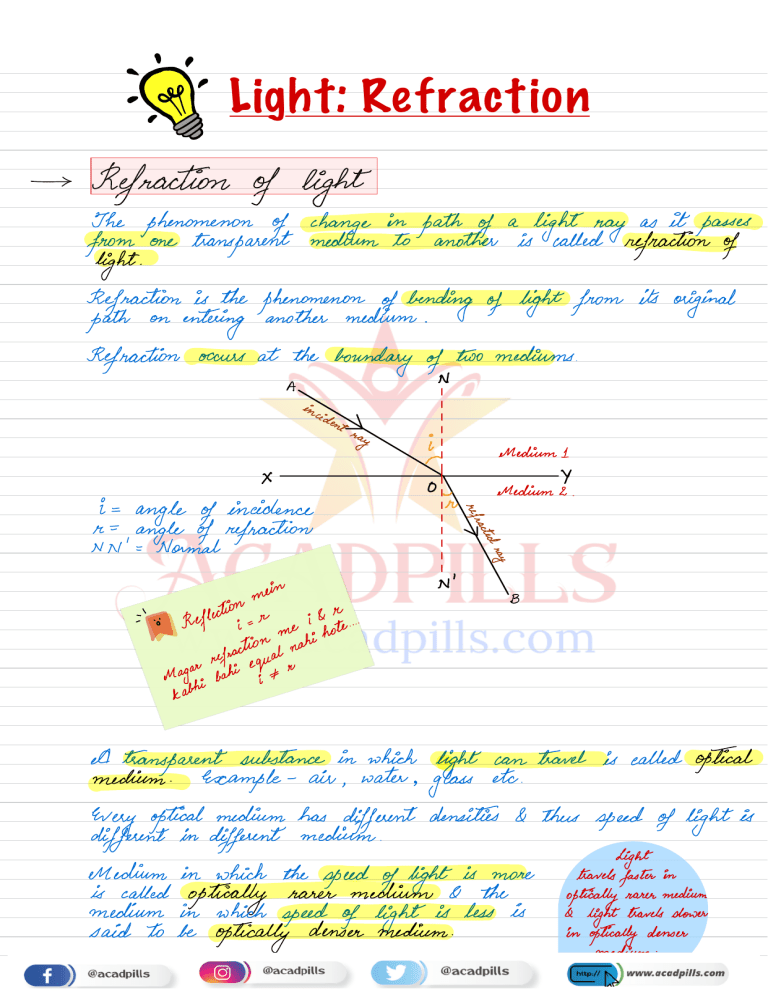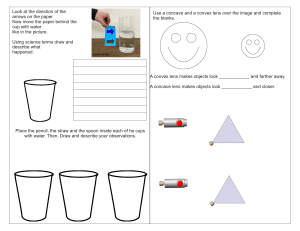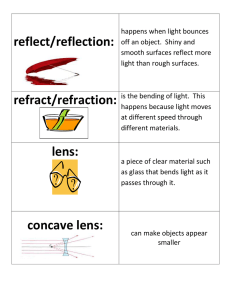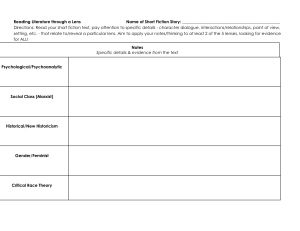
É☒¥&⑧¥ Light: Refraction - . → Refraction of light phenomenon of change from transparent medium The of path to another in one light Refraction light ray called is a as it passes refraction of . path on Refraction is the entering occurs phenomenon of bending of light from another medium its original . at the boundary of mediums two . N A incident may i Medium 1 Y ✗ Medium 2 ° E- incidence r= NN ' angle of angle of refraction = " Normal refractequal ion , ° Kabhi ed transparent medium Every optical in different Medium called medium said to in B me i + i&hoe% . . . make n substance in which water air hseample . %9e-e.ee - , , medium has medium different different which ' N Reflection ?ñn " . & Magar baht is " the light glass can etc densities travel is called optical . & thus speed of light is . speed of light medium & optically in which speed of light is be optically denser medium rarer is Light more the less . is travels optically & in faster light rarer in medium travels slower optically denser medium . - Direction while bending of going from When light towards the i normal light rarer a travels of from denser medium to rarer a - denser medium to , it bends . > r N A incident way i. Rarer Y ✗ Denser g.gg & N ' B when When going from denser from light travels the normal away from i. to rarer denser a medium to . medium rarer , it bends . A < n N si Eso B- X °" " ° Y % Rarer Kacey > say N - causes The going from bends cause one of refraction medium enters into light towards the normal increases B of refraction basic When ' a & it bends to is the change the other , its when it enters away from the speed of light in . denser medium & in speed rarer the normal . decreases & it medium , its speed hscample when of light travelling in air enters ray the speed of light decreases Similarly when ray of in enters into air the increases speed of light glass into a , . , , glass , light travelling a . hscamples of refraction of light tank water to be raised pool appears containing due to which takes place when light rays passes refraction of light from pool of water into the air bottom The of a or . - The letters placed - ed over pencil viewed through glass of refraction of light documents because the slab to be appears the because bigger immersed part of pencil of . kept in water in glass thumb appears original siege when viewed from the sides ed lemon its a . immersed in water partially inside - when of light coming from refraction water the - be raised to appears a er to be bigger than . , Refraction through a rectangular glass slab ^ I f- • ÷ Glass . Glass → slab EF 00 - GH i, - ' - ray • " ☒i refracted ray emergent incidence ray P - Glass slab edie . - a. incident C ÷? B - - denser rarer angle of angle of refraction rise angle of emergence lateral displacement - . re - When a parallel In glass enters light ray the incident to slab the . a glass say refraction slab , then the emergent ray is . takes place twice , first when the ray enters the slab glass slab air from glass & enters the air incidence I of is & - if Laws ii] distance between the when incident refraction emergent out light passes ray displacement incident bound the medium . No • Garate takes egg at equal the reaction ? - to Yockey that refractivemedia of index - . the ray media , transparent same . of refraction The incident two emergence is on of any no the ray called lateral normallytwo place angle of perpendicular The - light When then to the Nz = , slab equal is displacement glass a escisls the ray . Angle of Lateral & second when the plane , the normal to the incidence , interface of all lies in the the The ratio of angle of incidence to the sine of angle of refraction is light of given colour & for the given pair of of refraction for media It is true & ray point of . Snell 's law constant refracted at the - of sine a a . If i is the for angle i 0 < angle of incidence skinnier The constant with respect = value is to the < 90° & r is the angle of refraction , then constant Cn) called first . refractive index of the second medium - Refractive Refractive when it Absolute index index is enter the of how from air index defined represented by refractive indexin air speed of light It is n as in the speed of light Absolute . changes . index of refractive the ratio Absolute - speed of light much measure medium refractive to the vacuum a medium refractive . medium is a of speed of light simply index is in called . vacuum almost is equal to the refractive index of a medium n ample lose Refractive - index of = , n = speed of light in speed of light in in :÷:÷:÷:g÷w water , nwatee denser of w w.vahw ithfractiveindeso & compared ☒ of refractive in medium as nz , N 21 n = = - 1 to one 2 with is to in in in medium 1 medium 2 , medium ratio . Speed of light speed of light ¥2 light passes fromthe another medium respect given by speed of light index & . When to 2 = optically are denser than air index 21 3×108 2. 25 ✗ 108 Glass & water i. medium the represented " . refractive Relative . medium speed of light in air speed of light in water = = , /air vacuum to jilt light light . Absolute index relative speed of of 1 the medium 2 medium 1 refractive called is speed of & is the similarly refractive medium 2 is , index represented by niz = 12 medium niz Speed of light in speed of light in = N of & , 1 given by is medium 2 medium 1 with respect to . Uzo , Absolute refractive Material medium edie Alcohol Kerosene oil Benzene glass of some material medium 1.52 Endesa Rock salt 1.54 Dense 1.50 Refractive 1-53 1.36 1.47 . Canada Balsam Carbon 1.46 media Material 1.33 1.44 quartz crown 0003 1.31 Water Turpentine Refractive index 1. Ice Fused index disulphide flint glass Ruby Sapphire Diamond 1.63 1.65 1- 71 t.TT 2.42 Spherical ed lenses spherical bound by two Spherical if Conner lens These lenses falling on a) Plano Koo types lens lens In - these is plane Concave - convex lens - In - converse lens - In these it converge the light rays - lenses one convex lenses surface concave Double they . surface is plane other & . converse these other c) as types surface b) Comesa lenses are thicker at the centre & thinner at etne - lens three of , . edges converging are usually glass) - . convex - are converging are Comesa lenses of are or it a , lenses lens ( piece of transparent material spherical surfaces both surfaces is is converse one is surface converse is & concave . convex lenses commonly both known convese surfaces as are convex converse lens . & iif concave lens centre lenses it Plano are . lenses Concave a) diverging lens - diverging are lens concave three of - lens lenses edge thicker at are thinner & the at - concave lens - surface Double concave lens , one is surface concave is plane the & . concave In these lenses other light falling the - In these lenses other Conresco they diverge as types surface converse c) Concave the plane b) - . These on or is concave is & the converse . concave In these lenses & commonly it is surface one both the known surfaces as are concave lens concave . r concave concave " " ° Mirror & lens Mirror opposite Lens . . . . . . - concave cornea hair - - converging diverging - concave Converse - - diverging converging . . important Some Aperture 1. Po terms Aperture of - the lens is the the lens diameter the is of the P principal axis 25-2 Q centre G) It is the refract 3. Centres point Q principal any curvature the centre is represented by the deviation lens concave centre Optical - on without of of aperture converse lens Optical outline . T 2. circular 0 the lens & is point of . ascis incident such that the , rays . centre of curvatures are the centres of spherical surfaces It is represented by c. The - too . eds there curvature Centre 4 of Principal . 5 . i] of lens , . curvature ascis - & 2F , - straight imaginary curvature is centres parallel to the are the two centres thus , is centre of represented through called passing principal ascis has two of curvature line as . 2F . both the . principal . It is the a rays point principal on starting ascis & infinity after refraction . , " ' c. 25-2 Q are Comesa lenses both Concave & - there of principal focus An focus , Czoe 25-2 double is principal focus become at or thus of Principal focus First spherical surfaces C two are principal axis of the lens directed to which from etne lens is image formed by , or ii Second principal focus converge of the the lens side ( conceive I ZF , coming . ÑÑÑ 00 ÷ µ " Concave are the same . P elbirroio Mein principal focus concave real & ka mirror focus converse & real hota hai . . . lens ka concave . . mirror convex hota hair virtual mein Lens mein virtual on \ , to - lens , meet to appears " principal , www.wg , or ZF 25-2 both Nd both on after refraction , g principal axis at which parallel to the principal axis point rays Ccomescd other side on the It is the - . . . . . . principal lens ka virtual ,••~ foie 6. Focal length The distance between the the lens is called centre - of Image formation by Different way (that as 1 . follows Ray For concave lens principal focus For the convene two the on lenses can any : incident principal focus used can lens this , be using to ray ) be used in ray after the , this principal focus ray after to appears to refraction passes refraction P p " s Q image of parallel . 25-2 optical . tense are . . lens length the diagram represent direction a focal & ZF , Q the principal the through pass through axis 2 . Ray passing through optical centre 6) passes straight after refraction P p ii. ZF 2Fz , Q 3. ed ray passing merges parallel Q through to the or directed principal ascis ZF , : 25-2 Q are , Position object •t infinity Between & 0 infinity centre optical the lens of . ÷¥± as concave follows lens image ¥Fa s Q studied at two be Position '¥¥ 21=1 can : Ray diagram of , lens concave formation by imagewhich positions focus after refraction the Q Image formation by The to siege of of & nature image Highly diminished - point sized - , edt tous Between & . Virtual & erect focus optical 0 F' F. Diminished centre Virtual & erect Image formation by convex lens HH Position object edt Ray diagram of infinity 2F , image i : µ; LÉ== , A Beyond position ☐ ZE A of siege & nature of image Ttighlydiminis herd - eat focus Fe - , sized point - Real & inverted Belioeenfz & 2Fz Diminished Real & inverted ' Q P A At 21=1 %, . ¥ I,É ¥ o . , At 21^-2 • A Real & invented ' Q ¥É A Between F, & IF , " : Q A' Beyond 21=2 Enlarged Real & inverted an ☒ ;¥÷z¥ A eat F , A , 0 highly enlarged ""& " or • • ' a optical " " """ centre , On the side as the lens of the Enlarged same virtual & erect object . < → convention Sign for spherical lenses " convention Sign The of → length lens focal of is concave Lens of a lens is convex negative similar to lens is mirrors positive . & . formula - Lens formula distance G) & Lens formula ÷ relationship focal length (f) the is is object distance cut = ¥ formula & mirror mein hai ggaieog lens image , GAUDHAN d- - between formulatear deteryaad mistake of "" & according be E. must cartesian f New values to etne . sign . - . toh humesha lens formula rakhein subtraction , me hair . hota → magnification lens is produced defined magnification by & the the of of image height height object The a the ratio as of the . It is represented by Magnification hi h m height of height of - - m , I. . height of image height of object = ¥ = imaged ellagnification distance G) is also related m mirror m = mien gh÷ = to the In image , image ? , virtual www.imdb minus pedhayaan sign heir distance Cu) & and hotter m.tk$0k object me , I • it ' i - dim Q edn lens of focal placed at length a 15cm . distance of 30cm from Find the nature & . distance , length f u = = - , lens formula ÷ I ÷ - + - ÷ Ego - - = -30cm 15cm , ¥ ¥5 50=-1-5 a concave position of → . Object Focal By is object image A - - the ÷ Ig ÷ to The 10 is to - = - -2-2 = 30 -3¥ = V = To - 10 am - negativethesign of am & erect virtual side same on shows v oii is hi is ' of - - Power Power diverge It is Power of that as at image is of object The . distance a image - always always +ve ens concave for lens convex for . is is - re + ve lens ofthelens defined is by represented of the abilityit of on lens to a unit when P . Powers . Ig = is lens is in metres , then 1m dioptre , power which is is in = f- = f- = I dioptre - lens - + ve - re represented by diopter - P lens concave of power of f f = or converge . reciprocal of focal length is lens as light falling rays of P When of ve convene SI is . o → that D . dioptre One i. D= Power another one P P = + , of Pz + the Pz Suitable combination used in to increase & image also to ed length 20cm power of A = P, = - - . given by . lenses µ - + . of focal placed length in contact 25 edlso = , = = -4 D. Power i. of To combination , P = = ! f- D= f- - : . f Lp = = Im IT . P = + Pz -25cm IOOF 1%-0 = -15 D P, + Pz -4 -15 ID . a comesa . 2 = & • . with each other +20cm = , Pz an calculate , lens fi lens fz concave comesa IN www.gw sharpness of comet defects of images profit now re the too , Individual taken are & ¥0 P metre powerswith -25 I one in contact with . combination ? the placed or µ are focal length of focal length of P, . of lenses lens concave . remove formed by single Q is power + combined are microscopes cameras, telescopes length lenses of lenses then , of focal leftward number a lens power of combination of when the is . lens of focal What is the focal length . . CLICK ON IMAGE TO JOIN US ON TELEGRAM CLICK HERE TO JOIN US ON TELEGRAM





